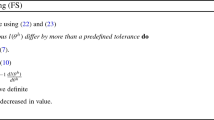Abstract
In this paper, the constrained maximum likelihood estimation of a two-level covariance structure model with unbalanced designs is considered. The two-level model is reformulated as a single-level model by treating the group level latent random vectors as hypothetical missing-data. Then, the popular EM algorithm is extended to obtain the constrained maximum likelihood estimates. For general nonlinear constraints, the multiplier method is used at theM-step to find the constrained minimum of the conditional expectation. An accelerated EM gradient procedure is derived to handle linear constraints. The empirical performance of the proposed EM type algorithms is illustrated by some artifical and real examples.
Similar content being viewed by others
References
Bentler, P.M. (1992).EQS Structural Equations Program Manual. Los Angeles: BMDP Statistical Software.
Bentler, P.M., & Weeks, D.G. (1980). Linear structural equations with latent variables,Psychometrika, 45, 289–308.
Bertsekas, D.P. (1976). Multiplier method: A survey.Automatica, 12, 133–145.
Dempster, A.P., Laird, N., & Rubin, D.B. (1977). Maximum likelihood from incomplete data via the EM algorithm.Journal of the Royal Statistical Society, Series B, 39, 1–38.
Dempster, A.P., Rubin, D.B., & Tsutakawa, J.R. (1981). Estimation in covariance components models.Journal of the American Statistical Association, 76, 341–353.
Goldstein, H., & McDonald, R.P. (1988). A general model for the analysis of multilevel data.Psychometrika, 53, 455–467.
Jamshidian, M., & Jennrich, R.I. (1993). Conjugate gradient acceleration of the EM algorithm.Journal of the American Statistical Association, 88, 1459–1471.
Jöreskog, K.G., & Sörbom, D. (1996).LISREL 8: Structural equation modeling with the SIMPLIS command language. Hove and London: Scientific Software International.
Kim, D.G., & Taylor, J.M.G. (1995). The restricted EM algorithm for maximum likelihood estimation under linear restrictions on the parameters.Journal of the American Statistical Association, 90, 708–716.
Lange, K. (1995). A gradient algorithm locally equivalent to the EM algorithm.Journal of the Royal Statistical Society, Series B, 57, 425–437.
Lee, S.Y. (1990). Multilevel analysis of structural equation models.Biometrika, 77, 763–772.
Lee, S.Y., & Bentler, P.M. (1980). Some asymptotic properties of constrained generalized least squares estimation in covariance structure models.South African Statistical Journal, 14, 121–136.
Lee, S.Y., & Poon, W.Y. (1992). Two level analysis of covariance structures for unbalanced design with small level one samples.British Journal of Mathematical and Statistical Psychology, 45, 109–123.
Lee, S.Y., & Poon, W.Y. (1998). Analysis of two-level structural equation models via EM type algorithms.Statistica Sinica, 8, 749–766.
Lee, S.Y., & Tsui, K.L. (1982). Covariance structure analysis in several populations.Psychometrika, 47, 297–308.
Lindley, D.V. & Smith, A.F.M. (1972). Bayes estimation for the linear model.Journal of the Royal Statistical Society, Series B, 34, 1–42.
Longford, N.T. & Muthén, B. (1992). Factor analysis for clustered observations.Psychometrika, 57, 581–597.
Louis, T.A. (1982). Finding the observed informationmatrix when using the EM algorithm.Journal of the Royal Statistical Society, Series B, 44, 226–232.
McDonald, R.P., & Goldstein, H. (1989). Balanced versus unbalanced designs for linear structural relations in two-level data.British Journal of Mathematical and Statistical Psychology, 42, 215–232.
Meng Xiao-Li, & Rubin, D.B. (1991). Using EM to obtain asymptotic variance-covariance matrices: The SEM algorithm.Journal of the American Statistical Association, 86, 899–909.
Meng Xiao-Li, & Van Dyk, D. (1997). The EM Algorithm-an old folk-song sung to a fast new tune. (with discussion)Journal of the Royal Statistical Society, Series B, 59, 511–567.
Morisky, D.E., Tiglao, T.V., Sneed, C.D., Tempongko, S.B., Baltazar, J.C., Detels, R., & Stein, J.A. (1998). The effects of establishment practices, knowledge and attitudes on condom use among Filipina sex workers.AIDS Care, 10, 213–220.
Muthén, B. (1989). Latent variable modeling in heterogeneous populations.Psychometrika, 54, 557–556.
Raudenbush, S.W. (1995). Maximum likelihood estimation for unbalanced multilevel covariance structure models via the EM algorithm.British Journal of Mathematical and Statistical Psychology, 48, 359–370.
Rubin, D.B. (1991). EM and beyond.Psychometrika, 56, 241–254.
Author information
Authors and Affiliations
Additional information
This research was supported by a Hong Kong UCG Earmarked Grant, CUHK 4026/97H. We are greatly indebted to D.E. Morisky and J.A. Stein for the use of their AIDS data in our example. We also thank the Editor, two anonymous reviewers, W.Y. Poon and H.T. Zhu for constructive suggestions and comments in improving the paper. The assistance of Michael K.H. Leung and Esther L.S. Tam is gratefully acknowledged.
Rights and permissions
About this article
Cite this article
Lee, SY., Tsang, SY. Constrained maximum likelihood estimation of two-level covariance structure model via EM type algorithms. Psychometrika 64, 435–450 (1999). https://doi.org/10.1007/BF02294565
Received:
Revised:
Issue Date:
DOI: https://doi.org/10.1007/BF02294565




